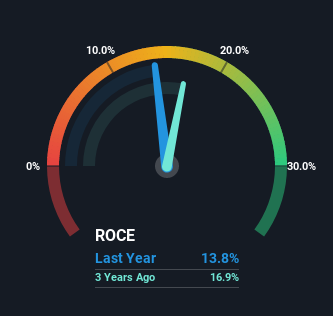- Saudi Arabia
- /
- Basic Materials
- /
- SASE:3030
Saudi Cement (TADAWUL:3030) Has Some Difficulty Using Its Capital Effectively
What underlying fundamental trends can indicate that a company might be in decline? Typically, we'll see the trend of both return on capital employed (ROCE) declining and this usually coincides with a decreasing amount of capital employed. Ultimately this means that the company is earning less per dollar invested and on top of that, it's shrinking its base of capital employed. On that note, looking into Saudi Cement (TADAWUL:3030), we weren't too upbeat about how things were going.
Return On Capital Employed (ROCE): What Is It?
For those that aren't sure what ROCE is, it measures the amount of pre-tax profits a company can generate from the capital employed in its business. The formula for this calculation on Saudi Cement is:
Return on Capital Employed = Earnings Before Interest and Tax (EBIT) ÷ (Total Assets - Current Liabilities)
0.14 = ر.س314m ÷ (ر.س3.4b - ر.س1.1b) (Based on the trailing twelve months to September 2022).
So, Saudi Cement has an ROCE of 14%. In absolute terms, that's a satisfactory return, but compared to the Basic Materials industry average of 6.2% it's much better.
Check out our latest analysis for Saudi Cement

Above you can see how the current ROCE for Saudi Cement compares to its prior returns on capital, but there's only so much you can tell from the past. If you'd like, you can check out the forecasts from the analysts covering Saudi Cement here for free.
What Can We Tell From Saudi Cement's ROCE Trend?
We are a bit anxious about the trends of ROCE at Saudi Cement. To be more specific, today's ROCE was 19% five years ago but has since fallen to 14%. What's equally concerning is that the amount of capital deployed in the business has shrunk by 21% over that same period. The combination of lower ROCE and less capital employed can indicate that a business is likely to be facing some competitive headwinds or seeing an erosion to its moat. If these underlying trends continue, we wouldn't be too optimistic going forward.
In Conclusion...
To see Saudi Cement reducing the capital employed in the business in tandem with diminishing returns, is concerning. Yet despite these concerning fundamentals, the stock has performed strongly with a 44% return over the last five years, so investors appear very optimistic. In any case, the current underlying trends don't bode well for long term performance so unless they reverse, we'd start looking elsewhere.
On a final note, we've found 1 warning sign for Saudi Cement that we think you should be aware of.
While Saudi Cement isn't earning the highest return, check out this free list of companies that are earning high returns on equity with solid balance sheets.
New: Manage All Your Stock Portfolios in One Place
We've created the ultimate portfolio companion for stock investors, and it's free.
• Connect an unlimited number of Portfolios and see your total in one currency
• Be alerted to new Warning Signs or Risks via email or mobile
• Track the Fair Value of your stocks
Have feedback on this article? Concerned about the content? Get in touch with us directly. Alternatively, email editorial-team (at) simplywallst.com.
This article by Simply Wall St is general in nature. We provide commentary based on historical data and analyst forecasts only using an unbiased methodology and our articles are not intended to be financial advice. It does not constitute a recommendation to buy or sell any stock, and does not take account of your objectives, or your financial situation. We aim to bring you long-term focused analysis driven by fundamental data. Note that our analysis may not factor in the latest price-sensitive company announcements or qualitative material. Simply Wall St has no position in any stocks mentioned.
About SASE:3030
Saudi Cement
Manufactures and sells cement and related products in the Kingdom of Saudi Arabia and internationally.
Very undervalued with flawless balance sheet.
Similar Companies
Market Insights
Community Narratives





